
Condenser
Functions
The Condenser has two major functions:
The Condenser Support Systems have the following functions:
Major Components
Condenser
There is usually one condenser for each low pressure turbine. The condenser has thousands of small tubes, that are made out of admiralty metal, copper, stainless steel, or titanium. The condenser is simply a large heat exchanger with tubes usually horizontally mounted. The tubes may be supported (or staked).
 |
The condenser has thousands of small tubes. On-line cleaning systems inject small balls during operation. Periodically, the tubes must be cleaned manually. During outages, the condenser tubes may be non-destructively tested to determine if wear is occurring. Tube leakage cannot be tolerated because the chemicals, e.g. sodium and chlorides can concentrate in the reactor (if a BWR) or steam generator (if a PWR). |
| Courtesy Nuclear News |
A probe that might be used to inspect the condenser tubes for defects, thinning, wear, corrosion is illustrated below:
 .
.
Courtesy Westinghouse Canada
The water from the circulating water system enters the condenser in a waterbox. The level in the waterbox must be maintained above the level of the uppermost tubes, otherwise the condenser will not be efficient. Generally the colder the circulating water, the more efficient the plant is. Power plants become less efficient when either the condenser tubes are fouled, e.g. by mud, plugging, or accumulation of other materials that reduce the ability to transfer heat from the steam to the water.
A condenser may heat the circulating water passing through as much as 40 degrees Fahrenheit.
The tubes are generally kept clean by a tube cleaning system that injects small abrasive sponge-like balls. In some cases, the power plant may have to reduce load so that the tubes can be cleaned manually.
Vacuum in the condenser is maintained by either a mechanical vacuum pump or steam driven air ejectors that suck gases (not steam) from the condenser.
The waterboxes are kept full using a air ejector or other system that keeps water level in the column from the waterbox as high as needed - above the tubes.
On the steam side of the condenser, the water collects at the bottom in a hotwell that provides the water source for the suction of the condensate pumps.
Copyright © 1996-2004. Joseph Gonyeau, P.E.. The Virtual Nuclear Tourist. All rights reserved. Revised: March 15, 2001